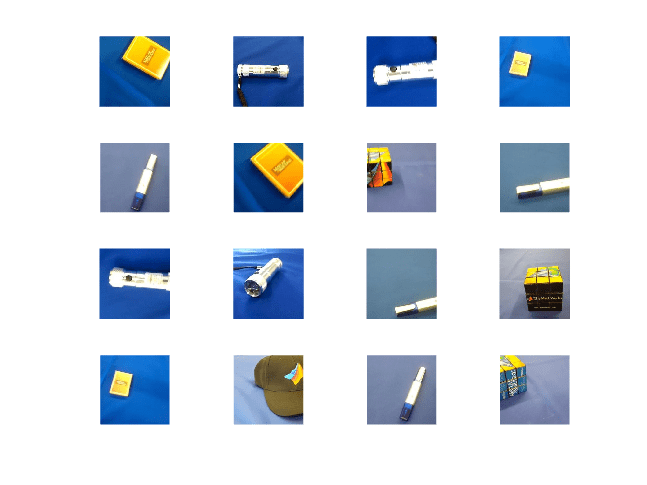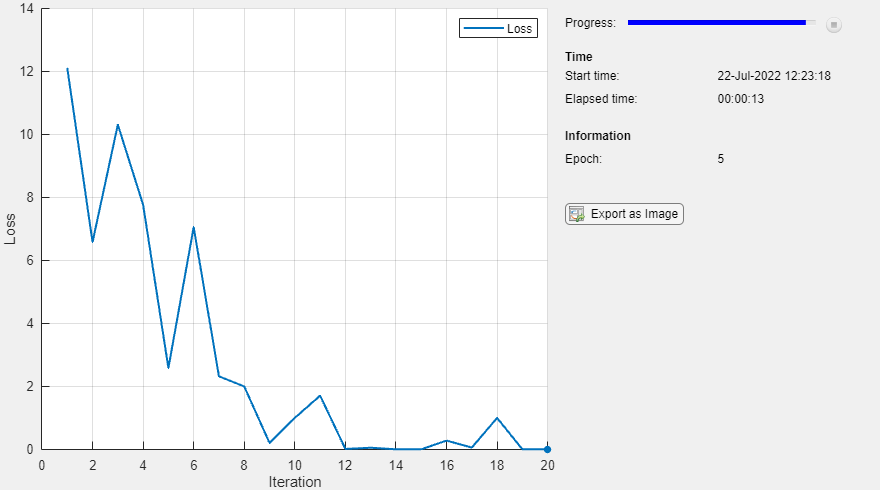freezeParameters
Convert learnable network parameters in ONNXParameters to
nonlearnable
Description
params = freezeParameters(
freezes the network parameters specified by params,names)names in the ONNXParameters
object params. The function moves the specified parameters from
params.Learnables in the input argument params to
params.Nonlearnables in the output argument
params.
Examples
Import the SqueezeNet convolution neural network as a function and fine-tune the pretrained network with transfer learning to perform classification on a new collection of images.
This example uses several helper functions. To view the code for these functions, see Helper Functions.
Unzip and load the new images as an image datastore. imageDatastore automatically labels the images based on folder names and stores the data as an ImageDatastore object. An image datastore enables you to store large image data, including data that does not fit in memory, and efficiently read batches of images during training of a convolutional neural network. Specify the mini-batch size.
unzip("MerchData.zip"); miniBatchSize = 8; imds = imageDatastore("MerchData", ... IncludeSubfolders=true, ... LabelSource="foldernames", ... ReadSize=miniBatchSize);
This data set is small, containing 75 training images. Display some sample images.
numImages = numel(imds.Labels); idx = randperm(numImages,16); figure for i = 1:16 subplot(4,4,i) I = readimage(imds,idx(i)); imshow(I) end

Extract the training set and one-hot encode the categorical classification labels.
XTrain = readall(imds);
XTrain = single(cat(4,XTrain{:}));
YTrain_categ = categorical(imds.Labels);
YTrain = onehotencode(YTrain_categ,2)';Determine the number of classes in the data.
classes = categories(YTrain_categ); numClasses = numel(classes)
numClasses = 5
SqueezeNet is a convolutional neural network that is trained on more than a million images from the ImageNet database. As a result, the network has learned rich feature representations for a wide range of images. The network can classify images into 1000 object categories, such as keyboard, mouse, pencil, and many animals.
Import the pretrained SqueezeNet network as a function.
squeezenetONNX() params = importONNXFunction("squeezenet.onnx","squeezenetFcn")
Function containing the imported ONNX network architecture was saved to the file squeezenetFcn.m. To learn how to use this function, type: help squeezenetFcn.
params =
ONNXParameters with properties:
Learnables: [1×1 struct]
Nonlearnables: [1×1 struct]
State: [1×1 struct]
NumDimensions: [1×1 struct]
NetworkFunctionName: 'squeezenetFcn'
params is an ONNXParameters object that contains the network parameters. squeezenetFcn is a model function that contains the network architecture. importONNXFunction saves squeezenetFcn in the current folder.
Calculate the classification accuracy of the pretrained network on the new training set.
accuracyBeforeTraining = getNetworkAccuracy(XTrain,YTrain,params);
fprintf("%.2f accuracy before transfer learning\n",accuracyBeforeTraining);0.01 accuracy before transfer learning
The accuracy is very low.
Display the learnable parameters of the network by typing params.Learnables. These parameters, such as the weights (W) and bias (B) of convolution and fully connected layers, are updated by the network during training. Nonlearnable parameters remain constant during training.
The last two learnable parameters of the pretrained network are configured for 1000 classes.
conv10_W: [1×1×512×1000 dlarray]
conv10_B: [1000×1 dlarray]
The parameters conv10_W and conv10_B must be fine-tuned for the new classification problem. Transfer the parameters to classify five classes by initializing the parameters.
params.Learnables.conv10_W = rand(1,1,512,5); params.Learnables.conv10_B = rand(5,1);
Freeze all the parameters of the network to convert them to nonlearnable parameters. Because you do not need to compute the gradients of the frozen layers, freezing the weights of many initial layers can significantly speed up network training.
params = freezeParameters(params,"all");Unfreeze the last two parameters of the network to convert them to learnable parameters.
params = unfreezeParameters(params,"conv10_W"); params = unfreezeParameters(params,"conv10_B");
The network is ready for training. Specify the training options.
velocity = []; numEpochs = 5; miniBatchSize = 16; initialLearnRate = 0.01; momentum = 0.9; decay = 0.01;
Calculate the total number of iterations for the training progress monitor.
numObservations = size(YTrain,2); numIterationsPerEpoch = floor(numObservations./miniBatchSize); numIterations = numEpochs*numIterationsPerEpoch;
Initialize the TrainingProgressMonitor object. Because the timer starts when you create the monitor object, make sure that you create the object immediately after the training loop.
monitor = trainingProgressMonitor(Metrics="Loss"); monitor.Info = ["LearningRate","Epoch","Iteration"]; monitor.XLabel = "Iteration";
Train the network.
epoch = 0; iteration = 0; executionEnvironment = "cpu"; % Change to "gpu" to train on a GPU. % Loop over epochs. while epoch < numEpochs && ~monitor.Stop epoch = epoch + 1; % Shuffle data. idx = randperm(numObservations); XTrain = XTrain(:,:,:,idx); YTrain = YTrain(:,idx); % Loop over mini-batches. i = 0; while i < numIterationsPerEpoch && ~monitor.Stop i = i + 1; iteration = iteration + 1; % Read mini-batch of data. idx = (i-1)*miniBatchSize+1:i*miniBatchSize; X = XTrain(:,:,:,idx); Y = YTrain(:,idx); % If training on a GPU, then convert data to gpuArray. if (executionEnvironment == "auto" && canUseGPU) || executionEnvironment == "gpu" X = gpuArray(X); end % Evaluate the model gradients and loss using dlfeval and the % modelGradients function. [gradients,loss,state] = dlfeval(@modelGradients,X,Y,params); params.State = state; % Determine the learning rate for the time-based decay learning rate schedule. learnRate = initialLearnRate/(1 + decay*iteration); % Update the network parameters using the SGDM optimizer. [params.Learnables,velocity] = sgdmupdate(params.Learnables,gradients,velocity,learnRate); % Update the training progress monitor. recordMetrics(monitor,iteration,Loss=loss); updateInfo(monitor,Epoch=epoch,LearningRate=learnRate); monitor.Progress = 100 * iteration/numIterations; end end

Calculate the classification accuracy of the network after fine-tuning.
accuracyAfterTraining = getNetworkAccuracy(XTrain,YTrain,params);
fprintf("%.2f accuracy after transfer learning\n",accuracyAfterTraining);0.99 accuracy after transfer learning
Helper Functions
This section provides the code of the helper functions used in this example.
The getNetworkAccuracy function evaluates the network performance by calculating the classification accuracy.
function accuracy = getNetworkAccuracy(X,Y,onnxParams) N = size(X,4); Ypred = squeezenetFcn(X,onnxParams,Training=false); [~,YIdx] = max(Y,[],1); [~,YpredIdx] = max(Ypred,[],1); numIncorrect = sum(abs(YIdx-YpredIdx) > 0); accuracy = 1 - numIncorrect/N; end
The modelGradients function calculates the loss and gradients.
function [grad, loss, state] = modelGradients(X,Y,onnxParams) [y,state] = squeezenetFcn(X,onnxParams,Training=true); loss = crossentropy(y,Y,DataFormat="CB"); grad = dlgradient(loss,onnxParams.Learnables); end
The squeezenetONNX function generates an ONNX model of the SqueezeNet network.
function squeezenetONNX() exportONNXNetwork(squeezenet,"squeezenet.onnx"); end
Input Arguments
Network parameters, specified as an ONNXParameters object. params contains the network
parameters of the imported ONNX™ model.
Names of the parameters to freeze, specified as 'all' or a string
array. Freeze all learnable parameters by setting names to
'all'. Freeze k learnable parameters by defining
the parameter names in the 1-by-k string array
names.
Example: 'all'
Example: ["gpu_0_sl_pred_b_0", "gpu_0_sl_pred_w_0"]
Data Types: char | string
Output Arguments
Network parameters, returned as an ONNXParameters object. params contains the network parameters updated by freezeParameters.
Version History
Introduced in R2020b
See Also
MATLAB Command
You clicked a link that corresponds to this MATLAB command:
Run the command by entering it in the MATLAB Command Window. Web browsers do not support MATLAB commands.
Select a Web Site
Choose a web site to get translated content where available and see local events and offers. Based on your location, we recommend that you select: .
You can also select a web site from the following list
How to Get Best Site Performance
Select the China site (in Chinese or English) for best site performance. Other MathWorks country sites are not optimized for visits from your location.
Americas
- América Latina (Español)
- Canada (English)
- United States (English)
Europe
- Belgium (English)
- Denmark (English)
- Deutschland (Deutsch)
- España (Español)
- Finland (English)
- France (Français)
- Ireland (English)
- Italia (Italiano)
- Luxembourg (English)
- Netherlands (English)
- Norway (English)
- Österreich (Deutsch)
- Portugal (English)
- Sweden (English)
- Switzerland
- United Kingdom (English)